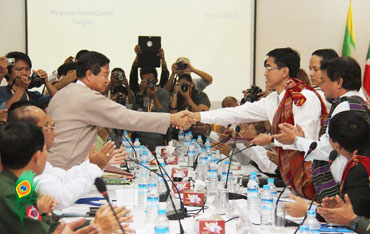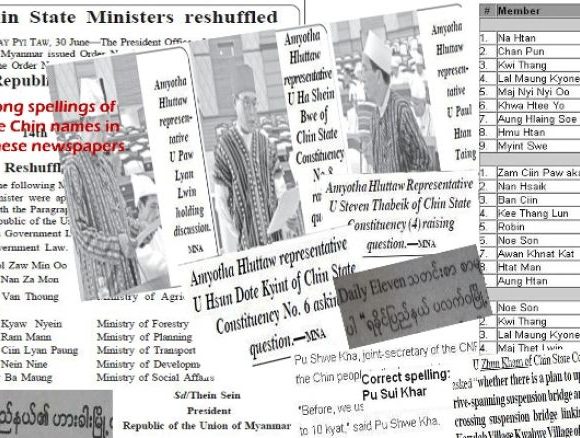A Test Case for Preventive Diplomacy (The Burmese Scene)
The “Hush Hush Talks” between the Junta and the pro democracy movement led by the Burmese Nobel laureate Daw Aung San Suu Kyi has been going on at a snail pace for more than a year and the UN special Envoy Razali Ismail will soon be on his 7th trip but so far nothing has been achieved. Likewise the International Labour Organization, the UN Special Rapporteur for Human Rights on Burma, the European Union’s Troika mission and several government missions have come and gone with no definite milestone to report. Now it has dawned on the international community that Burmese Junta is very reluctant on dialogue lest their hold on the power may be threatened and exposed their gregarious human rights violations.
In this aspect the Burmese military Junta is somewhat like a “bull”, a drought animal for pulling plough in agricultural Burma. The “bull” is so lazy to pull the plough that some one has to pull him by the nose front while another person has to whip him from the back. Thus in the dialogue process, the Burmese Nobel laureate, together with the exiled provisional government better known as the National Coalition Government of the Union of Burma and the ethnic forces have to pull it from the front, while the ILO, the UN and the Western countries have to baton him from the back to make it move. Even then it move slowly.
Talking to Daw Aung San Suu Kyi instead of wild attack in their media, releasing a few political prisoners and allowing the National League for Democracy (NLD, the winning party in the elections) to open their office in Rangoon are just some small positive gestures responded grudgingly by the Junta to ease both domestic, economic and international pressure. The dialogue have help them to gain some legitimacy for international aid while at the same time consolidated their position such as business deals with neighbouring countries so much so that they hope the international community would eventually have to bite the bullet and accept the status quo.
One can ask of why did the bull move so slowly, the answer is simple, because it is strong having eaten a lot of grass and other nutritious food i.e multilateral corporations and Association of Southeast Asian Nations (ASEAN) led by Malaysia and Singapore under the smokescreen of “Constructive Engagement” have been given tactical support to the Burmese military Junta. Imagine TotalFinaElf alone has to give $400 million annually just for the right to extract oil, not to mention Premier Oil of Britain and UNCOAL of the US. In this age of globalization where more and more power has been transferred from the governments to the big companies whose sole motive is to make profit, Burma seems to be the test case where the Western moral values have to yield to business considerations.
On the other hand the pro democracy and ethnic leaders have quietly attended the Paris Conference on their way back from Oslo where at the French National Assembly they paint the likely and alternative scenario to the international community .The most conspicuous point is that will the international community accept Burma as Yugoslavia or Afghanistan? For throughout history; the Burmese kingdoms were founded on military strength and not through the hearts and minds of the people. It was only in 1947 prior to independence from Britain did Bogyoke Aung San leader of the Myanmar, a major militant tribe somewhat equal to the Taliban of Afghanistan attended the “Panglong Conference” as an equal partner of the nationalities, and founded the Union of Burma. However, Karen, Karenni (Kayah) Arakanese and Mon nationalities having experienced the long treacherous traits of the Myanmar leaders which was amply demonstrated during the Japanese occupation refrained from attending the Conference which later resulted in outright rebellion.
But the spirit of the Union prevailed, the proof of it was demonstrated when one nationality (e.g. Karen) or the Burmese Communist threatened Rangoon all the other ethnic groups joined hands to defend the Union. But this Union spirit was destroyed by the Burmese army coup in 1962 led by General Ne Win, who with his “Burmese Way to Socialism” took the country to the least developed status in the world. A mass demonstration resulted in 1988 was put down cruelly by shooting into the crowds and killing some 20,000 in six Burmese cities. The popular leader, the Nobel laureate Daw Aung San Suu Kyi daughter Aung San (the founding father of the Union of Burma) was effectively put under house arrest up to this day while the ethnic cleansing and forced relocation of the ethnic groups was carried on with might and main.
So after half a century of civil war, the ethnic leaders have taken the initiative by launching a ‘Tripartite Dialogue’ proposal i.e the military, the NLD and the ethnic nationalities based on the spirit of the former “Panglong Conference” to promote a peaceful political settlement and is appealing to the international community. It is to be remembered that Burma faced a constitutional problem – not a minority problem because the word minority will be just a few percentage of the population while the ethnic nationalities consist of 47%of the population and more than 55% of the country’s area (371,000 square miles bigger than Germany itself).
The Junta used to counter the nationalities as “Tribes” or “Hill Tribes” a term which denotes that Myanmar is the only civilized people and it is the bounden duty for the Myanmar to civilize these tribes. This belies the superior complex and the chauvinistic attitude on the part of the Myanmar, when it is a historical fact that Arakan, and Mon kingdoms preceded the Burmese kingdom at least by 500 years while the first Burmese kingdom was recorded only in 1044 AD. Besides the ethnic nationalities never fight against each other as in Yugoslavia where ethnic people killed each other. The nationalities fight only against the Myanmar chauvinism spearheaded by the Burmese army which somewhat equivalent to Taliban’s version of fundamentalism. Hence it is neither a minority problem or tribal problem or an ethnic problem which can be solved once democracy prevailed. The Burmese problem is not a horizontal problem but a vertical one, which has its bases on constitution that can be solved only through negotiations. This explicitly means that democracy, military rule and the constitution are intrinsically intertwined and cannot be resolved one without the other. This is the crux of the Burmese problem..
The Junta’s justification is that there are 135 national races or tribes in Burma implies that it is impossible to cater to everyone and therefore it is necessary to have a strong military to hold the country together. But the fact of the matter is that 65 of these so called 135 races reside in Chin hills (villages on top of the hills are so high that it is very difficult to communicate with each other naturally resulted in different dialect) which constitutes only 3% of the Burmese population. The different tribes speaking different dialects have live peaceably since time immemorial The Junta’s theory is not only to maintain a perpetual powerful army to suppress the democratic forces but also “divide and rule” policy over the nationalities.
The beauty of the Paris Conference is that it was initiated by non other than Karen and Karenni both of whom were not even signatory to the Panglong Conference of 1947. Together with Shan Democratic Union (the largest state in the Union of Burma) these leaders make it clear that they their only desire is to live in peace and harmony with all the people of the world once their rights are observe. It is to be seen whether the international community would use its preventive diplomacy and help oust the Burmese Taliban (Junta) and encourage the pro democratic and ethnic forces (Burmese Northern Alliance) to create a Federal Democratic Union of Burma or left to its fate as in Yugoslavia.
By Kanbawza Win
Chinland Guardian
February 27, 2002






